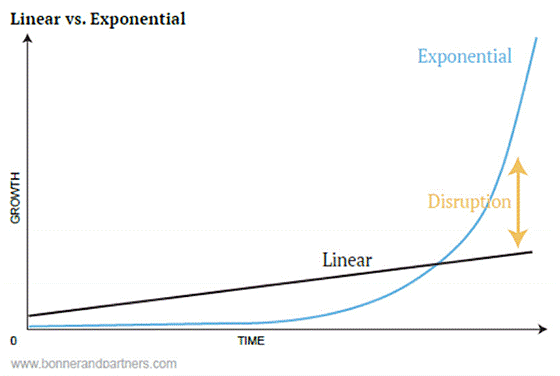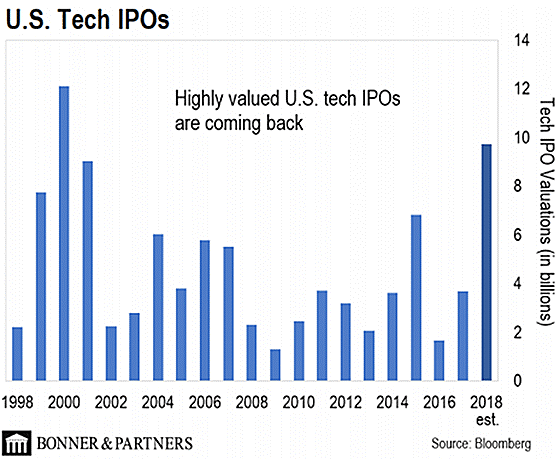Editor’s note: As readers may know, Jeff presented at the Legacy Investment Summit yesterday. He gave great insight on the “best strategies to profit from as stocks fall.” He also participated in a panel discussion – all about technology – with other investment greats.
One of those was tech expert Jeff Brown. With decades of experience in the tech sector – and all the skills that come with it – Jeff Brown is a true tech investing guru. That’s why for today’s Market Minute, we’ll leave it to him to tell us why investing in particular tech stocks right now could be the best decision you’ll ever make…
Over the next 10 years, advances in technology will bring such fundamental changes to our lives, they’ll dwarf all the progress we’ve seen since the great tech revolution began in the late 1990s.
Everything will change. The ways in which we work, shop, sleep, eat, travel, bank, communicate, entertain ourselves, conduct warfare, manufacture, design, distribute, create, transact, and maintain our health will all be different.
Already, we’ve seen radical developments in technology during the last two decades – streaming video, cell phones, the internet, etc. This has resulted in some life-changing returns from the high-technology companies powering these transformations.
But the advancements in technology we’ve seen to date are only incremental… In fact, they’re just the foundation for future technology-based innovations that will be exponential.
We’re on the cusp of a new tech revolution. And those who act now will be the first to realize the extraordinary wealth these changes will bring.
The Power of Exponential Growth
The difference between linear and exponential growth is summed up by the first chart below. With exponential growth, changes appear to grow quite slowly in the early stages.
But when it reaches a certain tipping point – the steep “ramp” you see in the chart – it takes off like a rocket. As an investor, you want to be in position before the ramp up.

Think about a company like Apple. It enjoyed explosive growth – and explosive gains in its share price – during the early years of the computer revolution. After that, the company held steady for quite a while.
But then, with the introduction of the iPhone in 2007, Apple’s stock began its meteoric rise. And in August 2018, Apple became the first publicly traded company valued at $1 trillion.

Had you purchased shares in Apple back in 2008, you’d now be seeing returns of 783%… or 921% if you had reinvested dividends.
We’ve seen other examples of exponential growth in the technology sector, too…
Over the last few decades, it took, on average, about 20 years for the typical Fortune 500 company to reach a valuation of $1 billion.
In 1998, Google reached $1 billion in market cap after only eight years, which was considered fast at the time.
By 2004, Facebook had done it in five years.
By 2009, Uber had done it in less than three years.
In 2012, virtual-reality firm Oculus did it in just over a year.
And as recently as 2014, a workplace productivity company called Slack pulled it off in only eight months.

As you can see, this trend is speeding up. And investors are reaping the benefits.
You may be wondering what accounts for this exponential growth in technology…
Moore’s Law
In 1965, before he co-founded Intel and became a billionaire, Gordon Moore was working as director of research and development for a company called Fairchild Semiconductor.
He was asked by Electronics magazine, a popular trade journal at the time, to predict what would happen in the semiconductor components industry. (You’ve probably heard of semiconductors. They’re the electronic components made up of integrated circuits that are essentially the “brains” of any kind of electronic machinery or consumer electronics product.)
Moore noted that the number of components in an integrated circuit doubled approximately every year. He predicted that this trend would continue for at least the next 10 years.
Later, Moore revised his prediction to say that a doubling would occur every two years.
This prediction, known today as “Moore’s Law,” has been astoundingly accurate. Microprocessors have become smaller, cheaper, and more powerful since 1965.
And as Moore predicted, the number of components in a semiconductor has doubled approximately every two years.
Thanks to Moore’s Law, we have an abundance of affordable, powerful electronics today. It’s the reason why the smartphone in your pocket has more computing power than all the computers originally used by NASA to send astronauts to the moon.
And while Gordon Moore originally made this observation with regards to computer chips, it also holds true for many other innovations in the tech space.
For instance, the number of bits per second that can be sent through an optical fiber cable has increased roughly 10 million-fold since 1980. That rate of growth actually far outpaces Moore’s Law.
And consider another example. The cost to sequence a human genome – providing a “blueprint” of a human’s genetic code – has fallen dramatically in recent years.
As you can see in the chart below, the cost of sequencing a human genome kept pace with Moore’s Law for the first eight years of the 21st century. But then, the cost plunged exponentially.

In 2001, the cost of sequencing a human genome was $100 million. At the time of this writing, the cost is just $1,000. That’s a 99.99% reduction of cost in less than two decades. That’s the power of exponential growth.
This sort of accelerated innovation will continue in the years ahead.
And investors now have ample opportunity to invest. Here’s why…
Return of the Tech IPO
I wrote to you recently to report that the number of exciting technology companies coming to market has picked up in 2018.
Thanks to readily available private capital, many technology companies have remained private, denying ordinary investors a chance to stake a claim. This has led to a backlog of exciting tech initial public offerings (IPOs).

But the good news is that, after years of low IPO numbers, we’re finally seeing the pace of tech IPOs pick up.
Tech IPOs in 2018 are estimated to hit a total valuation of $9.73 billion. That’s the highest level since 2000.
Prepare for the Future
Just 20 years ago, our world was a very different place.
Laptops and the modern internet were both a few years old, but neither had reached mainstream acceptance.
There were no digital music players… no smartphones… no tablets… We didn’t have Facebook or texting.
And if we got lost, there was no Google Maps to save us.
Over the next 10 years, we’ll see plenty more of these types of exponential advances. Barriers will be broken… whole new industries will be created… and fortunes will be made.
Computing power will surpass human brain power, and artificial intelligence (AI) will be everywhere.
Millions of autonomous, self-driving vehicles will shuttle passengers back and forth on U.S. highways. This will save lives, free up time, and reduce gasoline consumption, traffic, and car insurance premiums.
DNA sequencing, which now costs about $1,000, will soon cost less than $100, opening the door for new preventive and personalized medicine (and insurance coverage).
The average lifespan for anyone born in the last 20 years will exceed 100 years.
Smart investors will make a fortune. There has never been a better time to invest in cutting-edge technologies.
Regards,
Jeff Brown
Editor, Exponential Tech Investor
P.S. I’m always looking for the biggest opportunities in technology. And right now, there’s one key medical breakthrough progressing much faster than originally thought possible… and the possibilities are nearly limitless.
The smart investors – like Bill Gates and Jeff Bezos – are getting in now, because the small companies involved will go parabolic. To learn more about this breakthrough technology, read on here.